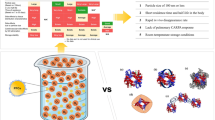This review addresses first- and second-generation perfluorocarbon emulsions, which are used as blood substitutes when the use of donor blood is problematic. The first perfluorocarbon preparations created as synthetic blood substitutes started to be used in Japan (Green Cross Corporation). These were the first-generation preparations Fluosol-DA 20%, Fluosol-DA 35%, and the Russian formulation Perftoran. The disadvantages of first-generation perfluorocarbon preparations were that they could not be sterilized, were unstable, and produced significant numbers of side effects. Second-generation emulsions include the American formulation Oxygent and the Russian formulations of the Ftoran series, which produce fewer side effects and can be rigorously sterilized and thawed quickly without alteration to their physicochemical or medical-biological properties. Further progress in creating artificial gas transporters and energy carriers based on fluoroorganic and organic compounds will lead to the wider use of emulsion nanosystems in many areas of medicine and biology.
Similar content being viewed by others
References
Yu. A. Ol’dekop and N. A. Maier, Introduction to Organoelemental Chemistry [in Russian], Vysshaya Shkola, Moscow (1973), pp. 32 – 35.
L. Clark and F. Gollan, Science, 152, 1752 – 1755 (1966).
H. Sloviter and T. Kamimoto, Nature, 216, 1634 – 1638 (1967).
R. Geyer, R. Monroe, and K. Taylor, Fed. Proc., 27, 384 (1968).
H. Makowski, P. Tentschev, P. Frey, et al., IV Internat. Symposium on Perfl. Blood Substitutes, Kyoto (1978), pp. 47 – 52.
R. Naito and K. Yokohama, Research on Perfluorochemicals in Medicine and Biology, Symposium Proceedings, Stockholm (1977), p. 42.
R. Naito, IV Internat. Symposium on Perfl. Blood Substitutes, Kyoto (1978), pp. 33 – 45.
S. I. Vorob’ev, G. R. Ivanitskii, K. N. Makarov, et al., Perfluorocarbon Emulsions [in Russian], Department of Scientific and Technical Information, Russian Academy of Sciences, Pushchino, Preprint (1993).
S. I. Vorob’ev, G. R. Ivanitskii, K. N. Makarov, et al., Physiological Activity of Fluorine-Containing Compounds (Experimental and Clinical Studies) [in Russian], Department of Scientific and Technical Information, Russian Academy of Sciences, Pushchino, pp. 33 – 41.
S. I. Vorob’ev, G. R. Ivanitskii, V. V. Moroz, et al., Vestn. Intensiv. Terapii, No. 2 – 3, 15 – 21 (1996).
S. I. Vorob’ev, G. R. Ivanitskii, K. N. Makarov, et al., Perftoran [in Russian], Department of Scientific and Technical Information, Russian Academy of Sciences, Pushchino (1997).
J. Riess, Artificial Organs, 5, 253 – 258 (1991).
J. Riess, S. Flaim, and D. Rlein, Physiological Activity of Fluorine-Containing Compounds (Experimental and Clinical Studies) [in Russian], Department of Scientific and Technical Information, Russian Academy of Sciences, Pushchino (1995), pp. 73 – 90.
T. Mitsuna, S. Tabuchi, and M. Ohyangi, Intern. Symp. on Perfluoroc. Blood Subst., Meinz (1981), p. 220.
R. Naito and K. Yokoyama, Technical Inf. Series, 1, 134 – 135 (1975).
H. Sloviter. M. Petkovic, S. Ogoshi, et al., Fed. Proc., 2, 453 – 455 (1969).
H. Beisbarth and F. Suyama, Intern. Symp. on Perfluoroc. Blood Subst., Meinz (1981), p. 13.
N. I. Afonin and G. Ya. Rozenberg, Probl. Gematol., 8, 49 – 53 (1979).
F. F. Beloyartsev, Perfluorinated Hydrocarbons in Biology and Medicine [in Russian], Department of Scientific and Technical Information, Russian Academy of Sciences, Pushchino (1980), pp. 19 – 28.
H. S. Chen and Z. H. Yang, Biomater. Artif. Cells Artif. Organs, 16, 403 – 409 (1988).
M. Blanc and J. Riess, Intern. Symp. on Perfluoroc. Blood Subst., Meinz (1981), p. 8.
S. I. Vorob’ev, Author’s Abstract of Doctoral Thesis in Biological Sciences, Moscow (1994).
S. I. Vorob’ev, V. A. Golovin, S. N. Davydova, et al., Vestn. Novykh Tekhnologii, 5(3 – 4), 84 – 88 (1998).
S. I. Vorob’ev, Ros. Zh. Anesteziol. Intensiv. Ter., 2, 18 – 24 (1999).
S. I. Vorob’ev, Author’s Abstract of Master’s Thesis in Biological Sciences, Moscow (1990).
T. H. Goodin, Second Annual IBC Conference on blood Substitutes, Meinz (1994), pp. 12 – 14.
R. F. Moore, Biomater. Artif. Cells and Artif. Organs,No. 1 – 3, 443 – 445 (1988).
K. Yokoyama, R. Naito, Y. Tsuda, et al., Program Clin. Biol. Res., 122, 189 – 191 (1983).
K. K. Tremper, A. E. Friedman, and E. M. Levin, Med., 307, 277 – 283 (1982).
G. M. Vercellotti, D. E. Hammerschmidt, P. R. Craddock, et al., Blood, 59, 1299 – 1304 (1982).
G. M. Vercellotti and D. E. Hammerschmidt, Int. Anent. Clinic, No. 1, 47 – 62 (1985).
Author information
Authors and Affiliations
Additional information
Translated from Khimiko-Farmatsevticheskii Zhurnal, Vol. 43, No. 4, pp. 30 – 40, April, 2009.
Rights and permissions
About this article
Cite this article
Vorob’ev, S.I. First- and second-generation perfluorocarbon emulsions. Pharm Chem J 43, 209–218 (2009). https://doi.org/10.1007/s11094-009-0268-1
Received:
Published:
Issue Date:
DOI: https://doi.org/10.1007/s11094-009-0268-1



